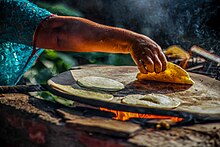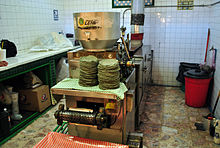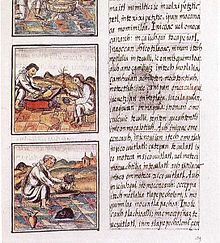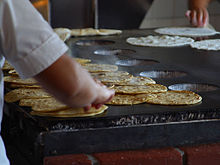Corn tortilla
A corn tortilla is a flat, circular bread made with nixtamalized corn, which is ground, made into dough, and cooked on a griddle. It is a preparation of pre-Columbian origin and is currently considered a food belonging to the basic basket in many American countries, highlighting Mexico, Guatemala, El Salvador, Honduras, Nicaragua and Costa Rica. It is consumed to accompany dishes, to wrap them or as the base of some recipes such as tacos, enchiladas, chilaquiles or quesadillas. They can also be fried to make tostadas, tortilla soup, or baked to make tortilla chips.
Tortillas in gastronomy
Corn tortillas are especially important in Mesoamerican gastronomy, with them tacos, golden tacos, flautas, quesadillas, enchiladas, chilaquiles, totopos, mulitas, entomatadas or enchiladas, enmoladas are prepared. They are consumed in Central America and Mexico, in Central America especially in Guatemala where the corn tortilla is part of the daily diet since they are consumed at each meal time together with the dish that is going to be tasted, likewise in El Salvador, Nicaragua, Costa Rica and Honduras.
Wheat flour tortillas are also made in these countries.
The importance of the tortilla in Mexico and Central America is such that it has been used in the daily diet since ancient times in various towns in the region (i.e. 500 BC. C. in Oaxaca), being part of the culture of many of the original peoples of America and its consumption transcending in many cases to the present day. In Spain since ancient times the word tortilla has been used in gastronomy and, with colonization, this name began to be used in America for preparations with similar geometric characteristics.
The tortilla can be defined as a flat, flattened, skinny, round bread made from corn. It is prepared based on nixtamalized corn; The process in which the corn grains are cooked in boiling water with a base of lime is indicated below. The process makes the corn take on a smooth consistency for easy digestion and its subsequent process will convert the grains into a uniform, yellowish-white dough or paste with which tortillas will be prepared. Tortillas can not only be made with nixtamalized corn, but also with corn flour, wheat flour, whole wheat flour, purple corn flour.
A tortilla in Costa Rica, Honduras, and Mexico is prepared by taking a ball of dough weighing a few grams and flattening it into a circular shape into a cake or flat disk about two millimeters thick and 15 centimeters in diameter, leaving approximately 21 grams after roasting. In El Salvador it is prepared in the same way, however the tortilla is about 1 centimeter thick and more or less 14 centimeters in diameter. For the process, both hands and a rolling pin or modern tortilla machines are used to obtain the appropriate shape of the tortilla prior to cooking.
In Guatemala it is done in the same way but it is done with their hands, the people who can prepare it have obtained an agility to do it in less than a minute, when they are prepared it has a characteristic sound (like they are clapping), then they are placed on a griddle, either made of clay or metal that is heated with firewood or gas, until they are cooked and have a consistency, the thickness varies according to who makes it.
For tortillas made in Panama, see Tortilla (Panama)
The tortilla is then baked on a hot flat surface, usually a griddle heated by a gas-produced flame or, in the traditional way, firewood or charcoal. The griddle used to cook tortillas is called a comal in Mexico and Central America. It is observed that the tortilla dough is heated and turned two to three times so that the tortilla takes its characteristic consistency. A good cooking will cause the tortilla to inflate due to the evaporation of the water contained in the dough, as would happen with bread, creating a membrane on each side of the tortilla, being more noticeable in the traditional tortilla this effect.
Once the tortillas come out of the comal, they are traditionally placed inside a basket made of dry fibers from the stem of the corn plant known as chiquihuite and covered with a small embroidered cloth blanket to conserve their well-known heat like napkin
Tortillas are eaten hot, they will always wrap another food, such as meat, eggs, and various foods that are generally salty, except in the case of sweet mole and other strong entrees, since it is a necessary complement to the main meal of the day.
There are preparations boiled in safflower oil or lard, under which the tortilla hardens acquiring the name of toast, the toasts are separated from the oil in metal strainers, and dry they can be prepared with different types of dressings and others salty foods.
In Mexican cuisine, tortillas made from white, blue or purple corn are popular, with yellow corn being the most popular. In Oaxaca, tlayudas are made, tortillas with a larger diameter and a slightly different texture.
In fact, the diameter of the tortilla, small, medium or large, can be a factor that gives qualities to certain foods and particularly to tacos; for example, small diameter tortillas are used exclusively in the preparation of tacos and this can be soaked and fried in oil. It is common for small diameter tortillas to be paired with a second tortilla to make a double tortilla taco. The cooking point of the tortilla is also important, because if they are cooked regularly and then cut into squares and fried in oil, they will become tortilla chips. There are many different ways to decorate the tortilla, as this is a mainstay in the culture of many Latin American countries.
History
The origin of the tortilla in Mesoamerica dates back before 500 B.C. C. For example, in the region of Oaxaca there is evidence that the tortilla began to be used at the end of the Villas Stage (1500 to 500 BC..), this is known because the clay plates used for its cooking appeared at that time. The pre-Columbian civilizations of Mesoamerica used corn as their basic food, just like the modern society of this same region.
The first chronicles of the Indies describe the Mesoamerican tortilla as corn bread, including the first translation into Spanish in the chronicle of Francisco López de Gómara of the name of the city of "Tlaxcala" was used as: .."Tlaxcallan, it means baked bread or house of bread; Well, more centli is caught there than in the surroundings"... Currently the toponymy of Tlaxcala is derived from Nahuatl: tlaxcalli tlán: place of tortilla.
Years later, Fray Bernardino de Sahagún, described in his General History of the Things of New Spain, some variants with his Nahuatl name:
- The tortillas that each day ate the lords were called totonqui tlaxcalli tlacuelpacholli, means white and hot tortillas, and bent, composed in a chiquíhuitlAnd covered with a white cloth.
- Each day they also ate other tortillas called ueitlaxcalli, means big tortillas; these were very white and very thin, and broad and very soft.
- They also ate other tortillas they called quauhtlaqualliThey are very white, thick, great and rough;
- They ate another variety of tortillas that were white, and some other paradillas, very good to eat, that they called tlaxcalpacholli;
- They also ate not round, but long breads, which they call tlaxcalmimilli; they are rolled and white and of a length of a palm or little less (According to DRAE, Memela. from the Nahuatl "mimilli").
- Another way tortillas were what they called tlacepoalli ilaxcalliThey were choked, they were delicate to eat. Of the meals used by the lords.
As can be seen in the aforementioned work by Sahagún, shortly after the conquest of Mexico, the use of the word tortilla had already been standardized in the Spanish language. However, each culture, in its respective language, called and continues to call this corn food differently:
| Language | Name |
|---|---|
| Spanish | tortilla |
| Nahuatl | tlaxcalli |
| Maya | Waaj |
| Totonaco | chaw |
| Mixteco | ndita |
| Zapoteco | eta, gueta |
| Otomí | hme |
| Rarámuri | remeke |
| triqui | cha'a |
The tortilla, especially the flour tortilla, has been part of the diet of astronauts prepared especially for space missions, since it has been preferred over toasted bread due to the amount of crumbs that the latter would produce and would let float in the interior space of the ship.
Inputs market for the production of corn tortillas in Mexico
According to reports from the Ministry of Economy and the Dough Regulatory Council, tortilla consumption in 2014 would be between 7.3 and 9.4 million tons, which indicates an average of 8.4 million tons of corn tortillas, updated figures from according to the estimated population for 2013.
Reports indicate that the tortilla in Mexico continues to be made mainly with nixtamalized corn dough, representing 65%, compared to 35% for corn flour, which is broken down as follows: 25% by Maseca, 8 % for Minsa, 1% for Harimasa, 0.50% for Cargill, 0.40% Macsa and 0.20% for Blancas.
| Nixtamal | 65 % |
| Maseca | 25 % |
| Minsa | 8 % |
| Harimasa | % |
| Cargill | 0.50 % |
| Macsa | 0.40% |
| Whites | 0.20 % |
Corn-flour, corn-tortilla chain
| Summary | Output | |
|---|---|---|
| Maíz | Corn flour | Nixtamal Mass |
| 1 kg | 0,938 kg nixtamalized corn flour | |
| 1 kg | 2,14 kg mass | 1.8 kg of mass |
| 1 kg | 1.56 kg tortilla | 1.4 kg tortilla |
There are studies that indicate that the corn-flour chain is more efficient than corn-tortilla, where 1,560 kg of tortilla is produced for each kilogram of corn and the nixtamalized corn-tortilla dough process produces 1,400 kg of tortilla for each kilo of corn used.
Techniques for making tortillas
Since time immemorial, the corn tortillas eaten in Mexico have been made by hand. In Mexico and Central America the verb tortear is used with the meaning of "make corn tortillas by flattening the ball of dough" Not only the making of the tortillas themselves but also Also the nixtamalization of the corn and the grinding of the nixtamal to produce the dough was carried out exclusively with human labor and ancient tools (metates with metlapiles to grind the dough, comales to cook the tortilla).
Towards the end of the 19th century, the first mechanical utensils for making tortillas began to be manufactured in Mexico, called tortilla presses, or tortilleras or tortilla makers. crush. These are artifacts that have two plates joined by a hinge, and a lever; They can be made of wood or metal. A ball of corn dough is placed on one of the plates, which will be crushed by the other plate by means of the pressure exerted on the lever. In this way, the disk of corn is obtained, which after cooking will become a tortilla. Also in the second half of the XIX century, the hand mill was introduced for the preparation of corn dough, as a substitute for basalt metate. Both the flattened tortilla machines and the hand mills are still used to this day. Throughout the first half of the 20th century, new ones appeared, some semi-manual, such as those devised by Salvador Guzmán in 1935 and the one manufactured by Félix Rábago in 1936. Both consist of two metal plates, but replace the lever with a squeegee that extends the nixtamal dough in the circular hole found in the upper plate, so that when lifting it you get the disk of dough.
Alternately to these double plate tortilla machines, roller machines appear later, a fundamental principle of today's industrial tortilla machines. The first of these is that of Luis Romero, from 1910. Five years later, the La India Company manufactured its roller machine with automatic cooking. The La India machine made the use of an external griddle for cooking the tortilla unnecessary. 3000 and 10,000 tortillas per hour, depending on the model.
Ecological advantages in the production of corn flour compared to nixtamal
The nixtamalization process continues to generate high contamination of the mixed liquid that is thrown down the drain and reaches lakes and rivers. Additionally, for every ton of corn that is washed and processed, between two thousand and three thousand liters of water are used.
Among the advantages offered by the production of corn flour are:
- Reduction of 81 per cent of water consumption.
- I save 55% on the use of gas to cook corn.
- Fuel saving in the corn cooking process, reducing greenhouse emissions to the atmosphere to an equivalent of 133 million kilograms of carbon dioxide.
- Reduction of drainage and household drainage problems by reducing wastewater discharges with solid waste of the order of 88%
- It reduces by 88% of wastewater discharges by preventing them from going to drainage 6.18 million cubic meters of polluting water are some of the advantages that make it possible.
Tortillas today
Tortillas are eaten every day. Tortilla factories (tortillerías) are very common, in Mexico, El Salvador, Honduras and Guatemala, they can be found in any city, town, neighborhood or on the same street.
In Mexico, tortillerías work from morning when the flour is prepared until late at night (around 6 in the afternoon). In Guatemala, similar hours are used, even reaching nine o'clock at night. Tortillas can also be purchased in some supermarkets and grocery stores.
The tortilla is a food that is consumed throughout the year, on any occasion, with all kinds of meals. Tacos can be made with any ingredient, although the most common is to prepare them with meat.
Using the tortilla you can prepare other foods such as: tacos, tortilla chips, tostadas, enchiladas, enfrijoladas, entomatadas, tortilla soup, quesadillas, chalupas, flautas, burritos, tacos dorados, sincronizadas, tostadas, chilaquiles. With the tortilla you can prepare tacos by serving any food inside the tortilla.
Tortillas have risen in popularity in other countries of the world, especially in the United States and Europe due to the Mexican cuisine that has been accepted in those countries and to a great extent to the versatility of the Mexican taco that can be prepared practically with any food.
Among supermarket products in the 21st century, it is common to find packages of tortillas, in plastic bags, packed and refrigerated. These, in general, are less favored than the original ones, made by hand and cooked on the griddle at the very moment of preparing the food.
In Central America, the popularly called hand tortillas predominate and their price is often higher than that of machine-made tortillas, the slightly thicker tortilla where, for example, in El Salvador the average is one centimeter. Today, instead of cooking them over wood—there are still places where they are heated like this—they cook them on special griddles, using LP gas for domestic use. Also in El Salvador, there is the chenga, which is a very wide and thick tortilla, on which food is placed (like an edible plate) for workers on farms and coffee plantations.
Colloquialisms and expressions
The concept of the tortilla and its characteristics have been used to illustrate or praise communication:
- "A lack of bread... tortillas". It is used when one must conform to the second option. In Spain, it is said In the absence of bread, good cakes.
- "He turned his tortilla". It refers to a sudden change in plans, usually a non-favorable change.
- "With copy" or "double". It refers to a taco being made with two tortillas.
- "Give him the horns". It refers to a type of superstition that is said when a taco is made on the "eroneo" side of the tortilla, and this is indicative that the person who is preparing the taco suffers from a romantic deception.
- "It was like a tortilla!". It means something's been crushed.
- "Someone's hungry". It refers to a type of superstition in which it is said that if one accumulates at least two pieces of different tortillas at the time of eating, someone is hungry.
- The terms "tortilla" and "tortillera" can be used pejoratively in some regions Spain and Latin America to refer to the lesbian woman.
- The name of the smallest state of the Mexican Republic refers to this food: "Tlaxcala", in Nahuatl, means "place where they make tortillas" or "place of -pan or tortilla- corn".
References and notes
- ↑ Mixed variant of Santo Tomás Ocotepec, Oaxaca
- ↑ Raichlen, Steven (1998). Cheers and seasoning. 200 delicious recipes from Mom's cuisine, all low in fat, salt and cholesterol! Miami: Prevention Health Books. p. 232. ISBN 0-87596-474-5. Consultation on 3 March 2011. "For millions of people, a meal would not be complete without tortillas. They are vital to the peoples of Mexico, Guatemala, El Salvador and Honduras. »
- ↑ a b Marcus Winter, Oaxaca, The archeological record, 2nd Ed. 2004 ISBN 968-7074-31-0
- ↑ "Mexicaca tortilla".
- ↑ artHistory Junta de Castilla y León In Tlaxcallan fragment of the History of the Conquest of Mexico cap.LV by Francisco López de Gómara
- ↑ Sahagún, Bernardino (2006) General History of the Things of New Spain, book VIII, chap. XIII, pp.444 ed. Porra ISBN 970-07-6492-3
- ↑ «File copy». Archived from the original on 26 November 2014. Consultation on 30 May 2014.
- ↑ «In 2014 Mexico expects to produce 8 million tons of tortilla». SDPnoticias.com. 2 May 2014. Archived from the original on February 15, 2018. Consultation on 14 February 2018.
- ↑ «In 2014 Mexico expects to produce 8 million tons of tortilla». www.cronica.com.mx. Consultation on 14 February 2018.
- ↑ "Gruma, by Juan González Moreno, will be the company of the IPC with the greatest growth in 2014". Excélsior. 23 May 2014. Consultation on 14 February 2018.
- ↑ "Juan González Moreno consolidates Gruma in Central America." Vanguardia. Consultation on 14 February 2018.
- ↑ «Maize omelette, popular product at global level». Publimeter Mexico. Consultation on 14 February 2018.
- ↑ Mexican Academy of Language (2001): Mexicanism Dictionary, Fund for Economic Culture, Mexico. (Internet version)
- ↑ Nixtamalization is a term that designates the production of nixtamal, that is, the corn precooked with lime that prepares the mass of the tortillas. It is an almost unknown process outside the Mesoamerican countries.
- ↑ Novelo, 1997: 66.
- ↑ a b Novelo, 1997: 67.
- ↑ "Our story", on the website of Celorio Tortilladoras, consulted on September 7, 2008.
- ↑ Digital, Millennium. "They create nixtamal that saves water and prevents pollution." Millennium. Consultation on 14 February 2018.
- ↑ "World Finance recognizes Mexican Gruma for its sustainability." SDPnoticias.com. 25 April 2014. Archived from the original on February 15, 2018. Consultation on 14 February 2018.
- ↑ Meza, Joaquin, Real Vulgar Dictionary Guanaca, ISBN 978-99923-79-60-5, p 178
Contenido relacionado
Luis Eduardo Aute
The patriotic song
Purple








